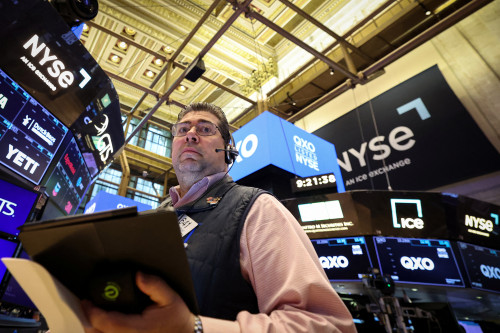
By Lewis Krauskopf
NEW YORK (Reuters) -Investors head into a busy week for economic data watching if leadership in the U.S. stock market could be moving away from defensive equity areas that indicates greater appetite for risk.
While the benchmark S&P 500 index is down 3.7% in 2025, with stocks jolted by concerns about economic damage from President Donald Trump’s tariffs, the consumer staples and utilities sectors, typically seen as more safe-haven areas of the market, are up this year 5% and 5.6%, respectively.
Investors often seek shelter in those groups because their businesses are considered relatively immune to economic slowdowns while the stocks tend to offer strong dividends.
“If the market is in a risk-off mode, those sectors will continue to lead,” said Chuck Carlson, chief executive officer at Horizon Investment Services.
More recently, however, as the U.S. market has rebounded from its lows over the past month, groups like technology, industrials and consumer discretionary that are more associated with upbeat economic sentiment, or “risk on” investor behavior, have been outperforming.
Leadership moving from defensive sectors to those areas or groups tied to the economy such as financials or energy could be “a sign perhaps that investors are regaining some animal spirits with regard to the prospects for the economy,” said Mark Luschini, chief investment strategist at Janney Montgomery Scott.
“That would be a tell of less caution being insinuated by investors,” Luschini said.
While data so far this year has indicated resilience in the economy, sentiment surveys and other “soft data” have been weak.
“What all macro investors are grappling with is, is this just a sentiment slowdown that’s being reflected in a defensive tilt within equities, or is this something more fundamental?” said Matthew Miskin, co-chief investment strategist at Manulife John Hancock Investments.
Economic data in the coming week provides a critical view. Tuesday’s April consumer price index will give a fresh read on inflation trends, while April retail sales on Thursday offers the latest window into consumer spending.
While economic fallout from the tariffs remains unclear, concerns abound that the import levies are poised to drive up prices and slow growth.
If CPI is hotter than expected and retail sales miss estimates, it could raise concerns about “stagflation,” Miskin said – a mix of sluggish growth and relentless inflation that could pressure stocks.
Some investors said the Federal Reserve appeared to nod to such worries at its meeting this week. The central bank held interest rates steady and said the risks of both higher inflation and unemployment had risen.
Aside from data, the coming week will see more U.S. companies posting quarterly results, including retailing giant Walmart, whose report stands to offer insight into consumer behavior and the cost of imported goods.
Stocks gained on Thursday after Trump and British Prime Minister Keir Starmer announced a trade agreement, the first since Trump triggered a global trade war with a barrage of levies on trading partners.
Investors will continue to be fixated on the Trump administration’s negotiations with other countries in hopes of more agreements after the president last month paused many of the heftiest tariffs for 90 days.
“Talks are starting to take place globally, and there is increased optimism that deals can be made before” the pause expires, CFRA strategists said in a note on Wednesday.
(Reporting by Lewis Krauskopf, Editing by Nick Zieminski)


